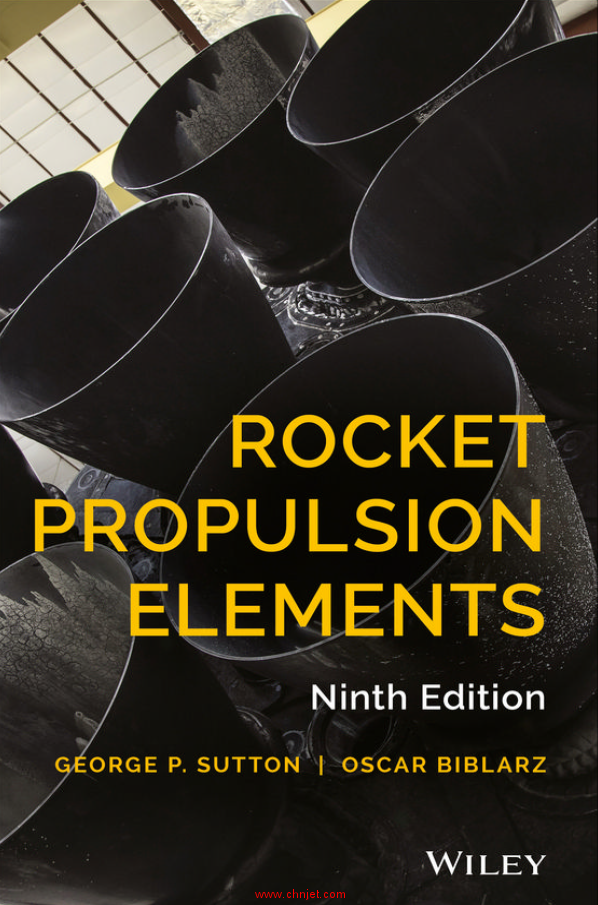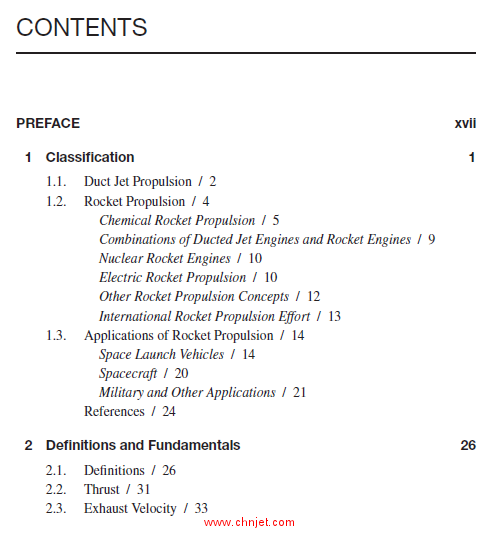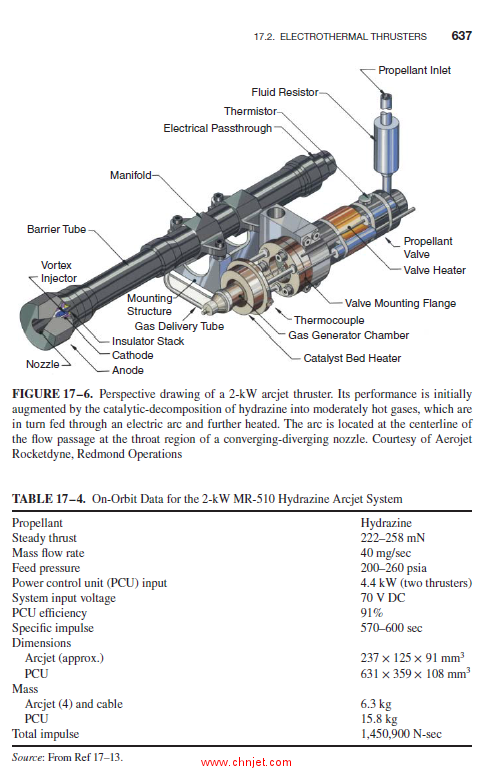马上注册,结交更多好友,享用更多功能,让你轻松玩转社区。
您需要 登录 才可以下载或查看,没有账号?立即注册


x
《Rocket Propulsion Elements》第九版
火箭推进要素
作者:
GEORGE P. SUTTON
Acknowledged expert on rocket propulsion
Formerly Executive Director of Engineering at Rocketdyne
(now Aerojet Rocketdyne)
Formerly Laboratory Associate at Lawrence Livermore National Laboratory
OSCAR BIBLARZ
Professor Emeritus
Department of Mechanical and Aerospace Engineering
Naval Postgraduate School
出版社:WILEY
出版时间:2017年
《Rocket Propulsion Elements》第九版

《Rocket Propulsion Elements》第九版

《Rocket Propulsion Elements》第九版

《Rocket Propulsion Elements》第九版

目录
PREFACE xvii
1 Classification 1
1.1. Duct Jet Propulsion / 2
1.2. Rocket Propulsion / 4
Chemical Rocket Propulsion / 5
Combinations of Ducted Jet Engines and Rocket Engines / 9
Nuclear Rocket Engines / 10
Electric Rocket Propulsion / 10
Other Rocket Propulsion Concepts / 12
International Rocket Propulsion Effort / 13
1.3. Applications of Rocket Propulsion / 14
Space Launch Vehicles / 14
Spacecraft / 20
Military and Other Applications / 21
References / 24
2 Definitions and Fundamentals 26
2.1. Definitions / 26
2.2. Thrust / 31
2.3. Exhaust Velocity / 33
v
vi CONTENTS
2.4. Energy and Efficiencies / 35
2.5. Multiple Propulsion Systems / 38
2.6. Typical Performance Values / 39
2.7. Variable Thrust / 40
Symbols / 41
Greek Letters / 42
Problems / 42
References / 44
3 Nozzle Theory and Thermodynamic Relations 45
3.1. Ideal Rocket Propulsion Systems / 45
3.2. Summary of Thermodynamic Relations / 47
3.3. Isentropic Flow through Nozzles / 51
Velocity / 52
Nozzle Flow and Throat Condition / 57
Thrust and Thrust Coefficient / 61
Characteristic Velocity and Specific Impulse / 63
Under- and Overexpanded Nozzles / 67
Influence of Chamber Geometry / 72
3.4. Nozzle Configurations / 73
Cone- and Bell-Shaped Nozzles / 75
3.5. Real Nozzles / 81
Boundary Layers / 82
Multiphase Flow / 83
Other Phenomena and Losses / 85
Performance Correction Factors / 85
Four Performance Parameters / 89
3.6. Nozzle Alignment / 91
Symbols / 93
Greek Letters / 93
Subscripts / 94
Problems / 94
References / 97
4 Flight Performance 99
4.1. Gravity-Free Drag-Free Space Flight / 99
4.2. Forces Acting on a Vehicle in the Atmosphere / 104
4.3. Basic Relations of Motion / 106
CONTENTS vii
4.4. Space Flight / 113
Elliptical Orbits / 116
Deep Space / 120
Perturbations / 121
Mission Velocity / 125
4.5. Space Flight Maneuvers / 127
Reaction Control System / 131
4.6. Effect of Propulsion System on Vehicle Performance / 133
4.7. Flight Vehicles / 136
Multistage Vehicles / 136
Stage Separation / 138
Launch Vehicles / 141
4.8. Military Missiles / 144
4.9. Flight Stability / 147
Symbols / 149
Greek Letters / 150
Subscripts / 150
Problems / 150
References / 152
5 Chemical Rocket Propellant Performance Analysis 154
5.1. Background and Fundamentals / 156
5.2. Analysis of Chamber or Motor Case Conditions / 161
5.3. Analysis of Nozzle Expansion Processes / 166
5.4. Computer-Assisted Analysis / 171
5.5. Results of Thermochemical Calculations / 172
Symbols / 185
Greek Letters / 186
Subscripts / 186
Problems / 186
References / 187
6 Liquid Propellant Rocket Engine Fundamentals 189
6.1. Types of Propellants / 192
6.2. Propellant Tanks / 196
6.3. Propellant Feed Systems / 203
Local Pressures and Flows / 203
6.4. Gas Pressure Feed Systems / 205
viii CONTENTS
6.5. Tank Pressurization / 212
Factors Influencing the Required Mass of Pressurizing
Gas / 214
Simplified Analysis for the Mass of Pressurizing
Gas / 215
6.6. Turbopump Feed Systems and Engine Cycles / 217
Engine Cycles / 218
6.7. Rocket Engines for Maneuvering, Orbit Adjustments,
or Attitude Control / 229
6.8. Engine Families / 232
6.9. Valves and Pipelines / 233
6.10. Engine Support Structure / 239
Symbols / 239
Subscripts / 239
Problems / 240
References / 242
7 Liquid Propellants 244
7.1. Propellant Properties / 245
Economic Factors / 245
Performance of Propellants / 246
Common Physical Hazards / 250
Desirable Physical Properties / 252
Ignition, Combustion, and Flame Properties / 254
Property Variations and Specifications / 254
Additives / 255
7.2. Liquid Oxidizers / 255
Liquid Oxygen (O2) (LOX) / 255
Hydrogen Peroxide (H2O2) / 256
Nitric Acid (HNO3) / 257
Nitrogen Tetroxide (N2O4) (NTO) / 258
Nitrous Oxide (N2O) / 259
Oxidizer Cleaning Process / 259
7.3. Liquid Fuels / 259
Hydrocarbon Fuels / 260
Liquid Hydrogen / 261
Hydrazine (N2H4) / 262
Unsymmetrical Dimethylhydrazine [(CH3)2NNH2] / 263
CONTENTS ix
Monomethylhydrazine (CH3NHNH2) / 263
7.4. Liquid Monopropellants / 264
Hydrazine as a Monopropellant / 264
7.5. Gaseous Propellants / 266
7.6. Safety and Environmental Concerns / 267
Symbols / 268
Greek Letters / 268
Problems / 268
References / 269
8 Thrust Chambers 271
8.1. Injectors / 276
Injector Flow Characteristics / 280
Factors Influencing Injector Behavior / 283
8.2. Combustion Chamber and Nozzle / 285
Volume and Shape / 285
Heat Transfer Distribution / 288
Cooling of Thrust Chambers / 289
Hydraulic Losses in the Cooling Passage / 295
Thrust Chamber Wall Loads and Stresses / 296
8.3. Low-Thrust Rocket Thrust Chambers or Thrusters / 300
8.4. Materials and Fabrication / 304
8.5. Heat Transfer Analysis / 310
General Steady-State Heat Transfer Relations / 311
Transient Heat Transfer Analysis / 315
Steady-State Transfer to Liquids in Cooling Jacket / 317
Radiation / 321
8.6. Starting and Ignition / 322
8.7. Useful Life of Thrust Chambers / 325
8.8. Random Variable Thrust / 326
8.9. Sample Thrust Chamber Design Analysis / 328
Symbols / 338
Greek Letters / 338
Subscripts / 339
Problems / 339
References / 342
9 Liquid Propellant Combustion and Its Stability 344
9.1. Combustion Process / 344
x CONTENTS
Injection/Atomization Zone / 346
Rapid Combustion Zone / 347
Streamtube Combustion Zone / 348
9.2. Analysis and Simulation / 348
9.3. Combustion Instability / 349
Rating Techniques / 357
Control of Instabilities / 358
Problems / 362
References / 362
10 Turbopumps and Their Gas Supplies 365
10.1. Introduction / 365
10.2. Descriptions of Several Turbopumps / 366
10.3. Selection of Turbopump Configuration / 371
10.4. Flow, Shaft Speeds, Power, and Pressure Balances / 376
10.5. Pumps / 378
Classification and Description / 378
Pump Parameters / 379
Influence of Propellants / 385
10.6. Turbines / 387
Classification and Description / 387
Turbine Performance and Design Considerations / 389
10.7. Approach to Turbopump Preliminary Design / 390
10.8. Gas Generators and Preburners / 393
Symbols / 395
Greek Letters / 396
Subscripts / 396
Problems / 396
References / 397
11 Engine Systems, Controls, and Integration 399
11.1. Propellant Budget / 399
11.2. Performance of Complete or Multiple Rocket Propulsion
Systems / 401
11.3. Engine Design / 403
11.4. Engine Controls / 412
Control of Engine Starting and Thrust Buildup / 413
Automatic Controls / 419
CONTENTS xi
Control by Computer / 421
11.5. Engine System Calibration / 423
Engine Health Monitoring System / 428
11.6. System Integration and Engine Optimization / 430
Symbols / 431
Greek Letters / 431
Subscripts / 432
Problems / 432
References / 433
12 Solid Propellant Rocket Motor Fundamentals 434
12.1. Basic Relations and Propellant Burning Rate / 439
Mass Flow Relations / 444
Burning Rate Relation with Pressure / 445
Burning Rate Relation with Ambient Temperature
(Tb) / 449
Variable Burning Rate Exponent n / 452
Burning Enhancement by Erosion / 453
Other Burning Rate Enhancements / 455
12.2. Other Performance Issues / 457
12.3. Propellant Grain and Grain Configuration / 462
Slivers / 471
12.4. Propellant Grain Stress and Strain / 472
Material Characterization / 473
Structural Design / 476
12.5. Attitude Control and Side Maneuvers with Solid
Propellant Rocket Motors / 483
Symbols / 485
Greek Letters / 486
Subscripts / 486
Problems / 486
References / 488
13 Solid Propellants 491
13.1. Classification / 491
13.2. Propellant Characteristics / 497
13.3. Hazards / 505
Inadvertent Ignition / 505
xii CONTENTS
Aging and Useful Life / 506
Case Overpressure and Failure / 506
Insensitive Munitions / 508
Upper Pressure Limit / 510
Toxicity / 510
Safety Rules / 510
13.4. Propellant Ingredients / 511
Inorganic Oxidizers / 513
Fuels / 516
Binders / 516
Burning-Rate Modifiers / 517
Plasticizers / 518
Curing Agents or Crosslinkers / 518
Energetic Binders and Plasticizers / 518
Organic Oxidizers or Explosives / 518
Additives / 519
Particle-Size Parameters / 520
13.5. Other Propellant Categories / 522
Gas Generator Propellants / 522
Smokeless or Low-Smoke Propellant / 523
Igniter Propellants / 524
13.6. Liners, Insulators, and Inhibitors / 525
13.7. Propellant Processing and Manufacture / 528
Problems / 531
References / 534
14 Solid Propellant Combustion and Its Stability 536
14.1. Physical and Chemical Processes / 536
14.2. Ignition Process / 540
14.3. Extinction or Thrust Termination / 541
14.4. Combustion Instability / 543
Acoustic Instabilities / 544
Analytical Models and Simulation of Combustion
Stability / 548
Combustion Stability Assessment, Remedy, and Design / 548
Vortex-Shedding Instability / 551
Problems / 552
References / 553
CONTENTS xiii
15 Solid Rocket Motor Components and Design 555
15.1. Rocket Motor Case / 555
Metal Cases / 559
Wound-Filament-Reinforced Plastic Cases / 561
15.2. Nozzles / 563
Classification / 564
Design and Construction / 566
Heat Absorption and Nozzle Materials / 571
15.3. Igniter Hardware / 577
Pyrotechnic Igniters / 578
Pyrogen Igniters / 579
Igniter Analysis and Design / 581
15.4. Rocket Motor Design Approach / 581
Problems / 589
References / 591
16 Hybrid Propellants Rocket Propulsion 593
16.1. Applications and Propellants / 594
16.2. Interior Hybrid Motor Ballistics / 599
16.3. Performance Analysis and Grain Configuration / 602
Dynamic Behavior / 605
16.4. Design Example / 607
16.5. Combustion Instability / 611
Symbols / 615
Greek Letters / 616
Subscripts / 616
Problems / 617
References / 618
17 Electric Propulsion 620
17.1. Ideal Flight Performance / 626
17.2. Electrothermal Thrusters / 631
Resistojets / 631
Arcjets / 634
17.3. Nonthermal Electrical Thrusters / 638
Electrostatic Devices / 638
Basic Relationships for Electrostatic Thrusters / 640
xiv CONTENTS
Electromagnetic Thrusters / 646
17.4. Optimum Flight Performance / 654
17.5. Mission Applications / 658
17.6. Electric Space-Power Supplies and Power-Conditioning
Systems / 661
Power Generation Units / 661
Power-Conditioning Equipment (PCU or PPU) / 664
Symbols / 665
Greek Letters / 666
Problems / 666
References / 668
18 Thrust Vector Control 671
18.1. TVC Mechanisms with a Single Nozzle / 673
18.2. TVC with Multiple Thrust Chambers or Nozzles / 683
18.3. Testing / 686
18.4. Integration with Vehicle / 687
Problems / 688
References / 688
19 Selection of Rocket Propulsion Systems 690
19.1. Selection Process / 692
19.2. Criteria for Selection / 697
19.3. Interfaces / 699
19.4. Cost Reduction / 700
References / 702
20 Rocket Exhaust Plumes 703
20.1. Plume Appearance and Flow Behavior / 705
Spectral Distribution of Radiation / 711
Multiple Nozzles / 714
Plume Signature / 714
Vehicle Base Geometry and Recirculation / 715
Compression and Expansion Waves / 716
20.2. Plume Effects / 717
Smoke and Vapor Trails / 717
Toxicity / 718
Noise / 719
CONTENTS xv
Spacecraft Surface Contamination / 720
Radio Signal Attenuation / 720
Plume Impingement on Structures / 722
Heat Transfer to Clusters of Liquid Propellant Rocket
Engines / 722
20.3. Analysis and Mathematical Simulation / 723
Problems / 724
References / 724
21 Rocket Testing 726
21.1. Types of Tests / 726
21.2. Test Facilities and Safeguards / 728
Monitoring the Environment and Controlling Toxic
Materials / 731
21.3. Instrumentation and Data Management / 735
Measurement System Terminology / 736
Test Measurements / 737
Health Monitoring System (HMS) / 738
21.4. Flight Testing / 739
21.5. Postaccident Procedures / 740
References / 741
Appendix 1 Conversion Factors and Constants 743
Conversion Factors (arranged alphabetically) / 743
Constants / 746
Appendix 2 Properties of the Earth’s Standard Atmosphere 747
Appendix 3 Summary of Key equations for Ideal Chemical
Rockets 749
Index 751
论坛里有《Rocket Propulsion Elements》第八版
http://forum.chnjet.com/thread-31054-1-1.html
专业书籍
下载地址:(回复后可见)
| ![]()
![]()